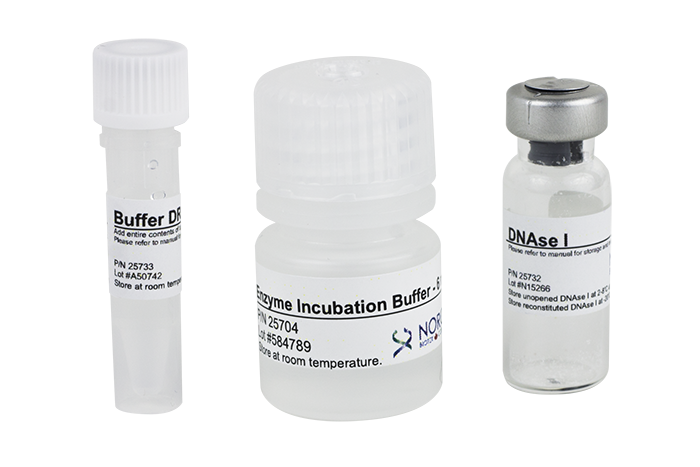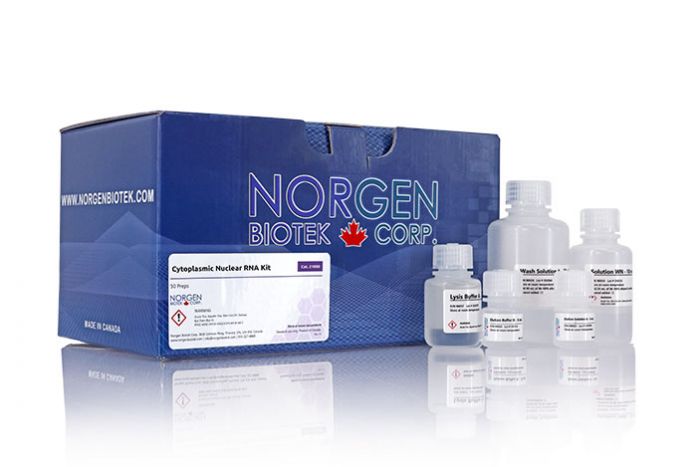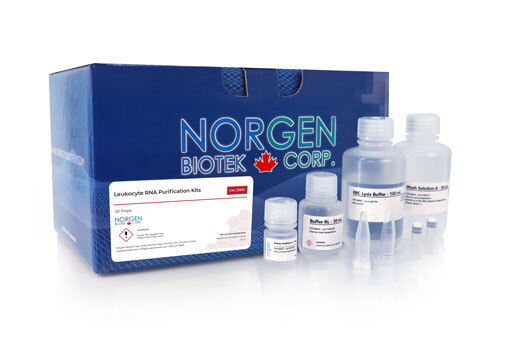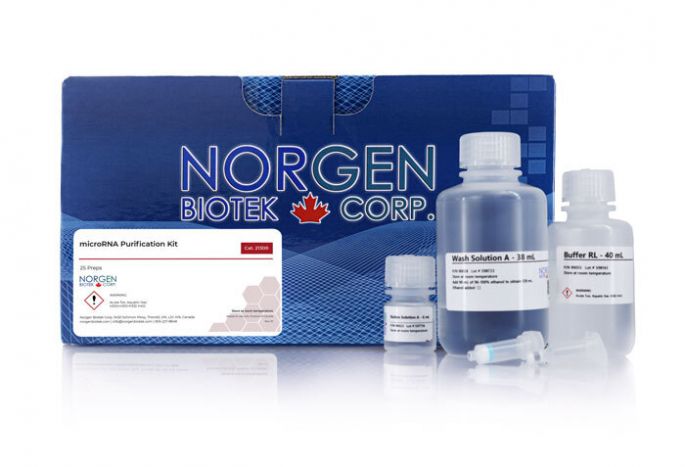Fatty Tissue RNA Purification Kit
For purification of total RNA (including microRNA) from animal tissues with high lipid content

For research use only and NOT intended for in vitro diagnostics.
Fatty Tissue RNA Purification Kit
For purification of total RNA (including microRNA) from animal tissues with high lipid content
Register today to receive an exclusive 15% off* on your first order.
Features and Benefits
- Isolate high quality total RNA from hard to extract fatty tissues
- Isolate total RNA, including microRNA (miRNA)
- No phenol or chloroform extractions
- Fast and easy processing using rapid spin-column format
- Genomic DNA removal without the use of nucleases
- Purification is based on spin column chromatography that uses Norgen’s proprietary resin separation matrix
This kit was deigned to extract high quality and yield from fatty tissues like brain, breast, adipose tissues, etc. Often tissues that have high fat contents like brain, breast tissues, etc., can lead to low quality and yield RNA with no-optimized kit.
This kit provides a rapid and optimized method for the isolation and purification of total RNA from animal tissues with high lipid content, including brain and adipose tissues. The kit purifies all sizes of RNA down to microRNA (miRNA) without the use of inhibitory phenol or chloroform. While the kit is optimized for fatty tissues, it can also be used for most mammalian tissue samples.
The purified RNA is of the highest integrity, and can be used in a number of downstream applications including RT-qPCR, microarrays, NGS.
Details
Supporting Data
Figure 1. Isolation of High Quality Brain Total RNA including microRNA without the use of Phenol. Norgen's Fatty Tissue RNA Purification Kit isolates high quality total RNA from fatty tissues such as brain without the use of phenol. Total RNA was isolated from equal amounts of brain tissue using Norgen’s Fatty Tissue RNA Purification Kit and a leading competitor’s kit that involves a phenol:chloroform extraction step. The purified RNA was then resolved on a 1.2% formaldehyde-agarose gel. As it can be seen, Norgen not only isolated high and consistent yields of total RNA, but the RNA was also of high quality as evidenced by intactness of the major 28S and 18S rRNA. Importantly, only Norgen's Fatty Tissue RNA Purification Kit was able to recover the small RNA fraction, including the microRNA (red-boxed).
Figure 2. High Yield of a Diversity of RNA Species. Norgen's Fatty Tissue RNA Purification Kit effectively recovers all sizes of RNA from large mRNA to small RNA, including microRNAs. Total RNA was isolated from equal amounts of brain tissue using Norgen's Fatty Tissue RNA Purification Kit and a leading competitor’s kit that involves a phenol:chloroform extraction step. The purified RNA was then used as the template in a RT-qPCR for detecting the beta-Actin gene (Top Panel) and for detecting miR-21 (Bottom Panel). In both graphs the blue lines correspond to Norgen isolated-RNA and the red lines correspond to competitor-isolated RNA. As it can be seen, Norgen's kit isolated higher yields of microRNA, as indicated by the lower Ct values of the blue lines (Top Panel). Also, Norgen's kit successfully isolated similar amount of large RNA to that of the competitor's kit (Bottom Panel) indicating the full diversity of RNA species isolated.
|
Kit Specifications
|
|
|
Maximum Column Binding Capacity
|
50 µg
|
|
Maximum Column Loading Volume
|
650 µL
|
|
Size of RNA Purified
|
All sizes, including small RNA
(<200 nt) |
| Maximum Amount of Starting Material: Brain and Adipose Tissues |
20 mg |
| Time to Complete 10 Purifications |
50 minutes
|
|
Average Yield*
Brain (15 mg) |
15 µg |
*Average Yield will vary depending on a number of factors including species, growth conditions used, and developmental stage.
Storage Conditions and Product Stability
All solutions should be kept tightly sealed and stored at room temperature. This kit is stable for 2 years after the date of shipment.
| Component | Cat. 36200 (25 preps) |
|---|---|
| Buffer RL | 30 mL |
| Lysis Additive B | 1 mL |
| RNase-Free Water | 15 mL |
| Wash Solution A | 38 mL |
| Elution Solution A | 6 mL |
| Mini Spin Columns | 50 |
| Collection Tubes | 50 |
| Elution Tubes (1.7 mL) | 50 |
| Product Insert | 1 |
Documentation
FAQs
Spin Column
Poor RNA recovery could be due to one or more of the following:
- Incomplete lysis of cells or tissue.
Ensure that the appropriate amount of Buffer RL was used for the amount of cells or tissue. - Column has become clogged.
Do not exceed the recommended amounts of starting materials. The amount of starting material may need to be decreased if the column shows clogging below the recommended levels. See FAQ related to “Clogged Column” below. - An alternative elution solution was used.
It is recommended that the Elution Solution A supplied with this kit be used for maximum RNA recovery. - Ethanol and Buffer RL was not added to the lysate.
Ensure that the appropriate amount of ethanol and Buffer RL is added to the lysate before binding to the column during the RNA purification step. - Ethanol was not added to the Wash Solution A.
Ensure that 90 mL of 96 - 100% ethanol is added to the supplied Wash Solution A prior to use. - Low RNA content in tissue used.
Different tissues have different RNA contents, and thus the expected yield of RNA will vary greatly from these different sources. Please check literature to determine the expected RNA content of your starting material. - Lysate was not diluted before removal of genomic DNA.
Ensure that 300 µL of RNase-Free Water is added to the lysate prior to genomic DNA removal by a spin column.
Column clogging can result from one or a combination of the following factors:
- Maximum amount of tissue exceeds kit specifications.
Refer to specifications to determine if the amount of starting material falls within kit specifications. - Centrifuge temperature too low.
Ensure that the centrifuge remains at room temperature throughout the procedure. Temperatures below 15°C may cause precipitates to form that can cause the columns to clog.
RNA can be degraded due to the following factors:
- RNase contamination.
RNases may be introduced during the use of the kit. Ensure proper procedures are followed when working with RNA. Please refer to “Working with RNA” at the beginning of this user guide. - Procedure not performed quickly enough.
In order to maintain the integrity of the RNA, it is important that the procedure be performed quickly. This is especially important for the Cell Lysate Preparation Step in the protocol, since the RNA in animal tissues is not protected after harvesting until it is disrupted and homogenized. - Improper storage of the purified RNA.
For short term storage, RNA samples may be stored at –20°C for a few days. It is recommended that samples be stored at –70°C for longer term storage. - Frozen tissues were allowed to thaw prior to RNA isolation.
Do not allow frozen tissues to thaw prior to grinding with the mortar and pestle in order to ensure that the integrity of the RNA is not compromised.
If the RNA does not perform well in downstream applications, it may be due to one or more of the following:
- RNA was not washed 3 times with the provided Wash Solution A.
Traces of salt from the binding step may remain in the sample if the column is not washed 3 times with Wash Solution A. Salt may interfere with downstream applications, and thus must be washed from the column. - Ethanol carryover.
Ensure that the dry spin under the Column Wash procedure is performed, in order to remove traces of ethanol prior to elution. Ethanol is known to interfere with many downstream applications.
Genomic DNA contamination could be because the lysate was diluted too much for removal of genomic by column. Ensure that 315 µL of RNase-Free Water is added to the lysate prior to genomic DNA removal by a spin column.
Yes, the Fatty Tissue RNA Purification Kit (#36200) can be used for cells with lipid droplets. Up to 2 million cells per extraction can be processed. Please feel free to contact our Tech support team at support@norgenbiotek.com for help with protocol.
Citations
| Title | Lipid Nanoparticles as a Shuttle for Anti-Adipogenic miRNAs to Human Adipocytes |
| Citation | Pharmaceutics 2023. |
| Authors | Anna-Laurence Schachner-Nedhere, Julia Fuchs, Ivan Vidakovic, Oliver Höller, Gebhard Schratter, Gunter Almer, Eleonore Fröhlich, Andreas Zimmer, Martin Wabitsch, Karin Kornmueller and Ruth Prassi |
| Title | MicroRNA expression is altered in lateral septum across reproductive stages |
| Citation | Neuroscience 2023. |
| Authors | M.C. Saula, †, C. Zhaoa, †, T.M. Driessena, B.E. Eisingera, S.C. Gammie |
| Title | RNA-seq reveals distinctive RNA profiles of small extracellular vesicles from different human liver cancer cell lines |
| Citation | Oncotarget 2023. |
| Authors | Berardocco, M., Radeghieri, A., Busatto, S., Gallorini, M., Raggi, C., Gissi, C., ... & Berardi, A. C. (2017). |
| Title | Seasonal heat stress affects adipose tissue proteome toward enrichment of the Nrf2-mediated oxidative stress response in late-pregnant dairy cows |
| Citation | Journal of Proteomics 2023. |
| Authors | Zachut, M., Kra, G., Livshitz, L., Portnick, Y., Yakoby, S., Friedlander, G., & Levin, Y. |




